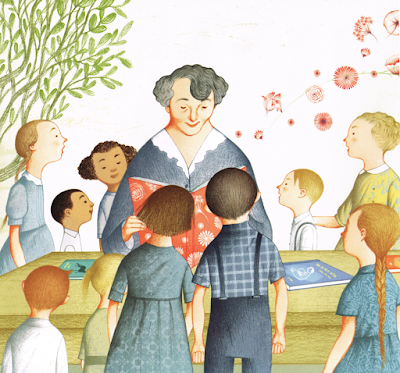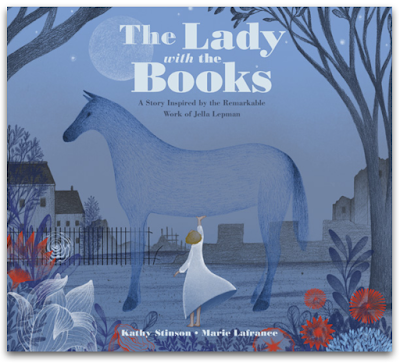Written by Kathy Stinson
Illustrated by Marie Lafrance
Kids Can Press
978-1-5253-0154-4
32 pp.
Ages 4-7
October 2020
"Let us set thisupside-downworld right againby starting withthe children.They will showthe grown-upsthe way to go."– Jella Lepman, 1943
So begins Kathy Stinson's homage to Jella Lepman, creator of the International Youth Library and a key player in the founding of IBBY (International Board on Books for Young People). But while The Lady with the Books honours her efforts to bring books to children, Kathy Stinson's newest picture book is much more than a biography. It is a tome of hope that books have the promise to nurture during difficult times.
 |
| From The Lady with the Books by Kathy Stinson, illus. by Marie Lafrance |
In the aftermath of World War II, a little girl, Anneliese, and her younger brother, Peter, wander the streets of Munich looking for food. What they do find, in addition to a bit of orange peel, is a line of people heading into a great hall filled with books. With memories of going to a library with their Papa, now both gone, the children are captivated and time flies until Anneliese and Peter are told by a kind lady that the exhibition was closing.
The next day they return to hear the same lady reading The Story of Ferdinand and are touched by the titular bull's pacifism, especially Peter who is drawn to flowers like Ferdinand. When this lady suggests that Anneliese might enjoy another book about a clever Pippi, Anneliese begins to imagine beyond the desolation of their daily lives, especially the struggle for food. The stories they hear at the exhibit and those that Anneliese weaves at night for her brother become a new source of sustenance, offering hope where there had been little.
Kathy Stinson's stories have always found ways to offer hope and comfort, easily getting into the heads of her characters and recognizing what is important to them. Whether it's colour (Red is Best) or music (The Man with the Violin) for children or a squirrel to The Dog Who Wanted to Fly, Kathy Stinson's picture books help children realize the importance of their dreams. At the onset of The Lady with the Books, Anneliese wonders why the women are clearing away rubble with their bare hands and sweeping the pavement when "Couldn't they see that the street would never be what it had been before the war?" However, by the story's end, she decides "she would join the women with their brooms. She would help clear the street around the damaged library. And maybe someday, the building would again be filled with books." There was hope again.
Marie Lafrance's illustrations, rendered in graphite pencil and coloured digitally, may reflect the devastating impacts of war, from bombed buildings to hunger, but the hope of Kathy Stinson's text and Jella Lepman's work–discussed in notes at the conclusion of the story–is there in the life peppering the scenes. From hardworking women with brooms, and men with wheelbarrows, trees and flowers growing out of rubble, markets of bright food, and books, books and more books, Marie Lafrance offers that buoyancy to the story, letting readers know that there is life and goodness out there.
Jella Lepman extended a hand to children after World War II, recognizing that more than food fed lives. Through book exhibitions, donations and ultimately the establishment of the International Youth Library, the largest international collection of children's books in the world, she nourished young lives, especially those disrupted by war and other disasters, to hope for better and more.
 |
| From The Lady with the Books by Kathy Stinson, illus. by Marie Lafrance |


Fascinating!
ReplyDelete